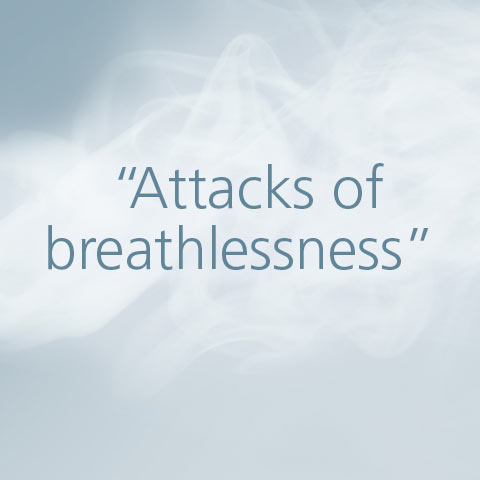The typical signs of asthma can be described as follows: Attacks of breathlessness that usually occur at night. There can be wheezing or humming sounds, mainly when the patient breathes out. Some people with asthma have a persistent cough. Others have no shortness of breath but a sense of extreme tightness in the chest or pain when they breathe in cold air.

It is typical for asthma that the symptoms fluctuate in their severity. They can also disappear altogether – either on their own or as a result of taking medication. They can also reappear at any time. This means that periods with asthma symptoms such as coughing, shortness of breath or acute attacks can be followed by periods where there are no symptoms.
Up to the age of 14, boys are more commonly affected by asthma than girls but the ratio reverses after this age. In some two-thirds of asthma cases the disease starts before the age of five. In about half of these children the asthma disappears before they are seven or over the course of puberty. The other half develops a chronic disease. Unfortunately, asthma symptoms are all too often overlooked in children. This is why we recommend that parents take their child to see a specialist if they suspect that he or she has asthma.
There are certain conditions that can encourage the development of asthma. Children who have or have had hay fever or neurodermatitis, for example, are at greater risk. Smoking, passive smoking or regular airway infections can also pave the way for asthma. Another risk factor is a low birth weight. These children are more likely to have asthma than their normal weight peers. Being overweight and not being physically active in childhood can also increase the risk of asthma.
The adolescent or adult patient has known about their disease for years in most cases. Unfortunately, they often consider themselves to be healthier than they actually are. This can mean that the disease continues to advance. The worst case is a life-threatening asthma attack with very notable asthma symptoms: As well as a racing heart beat (tachycardia), there can be extreme shortness of breath and blue discolouration of the lips and skin. If this happens call an ambulance immediately.
Many patients underestimate the role they themselves can play in their therapy. There are actually many ways they can actively prevent their health deteriorating. As well as taking their medication regularly, patients can use targeted breathing techniques, endurance training and patient training. And patients with allergic asthma benefit from rinsing with a nasal douche as a preventative measure.

Contact us
Any questions? You can reach us at this number:
01932 341122
© 2024 PARI GmbH Spezialisten für effektive Inhalation